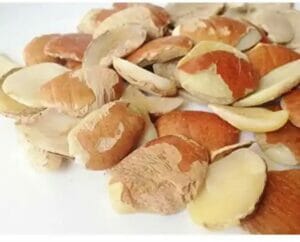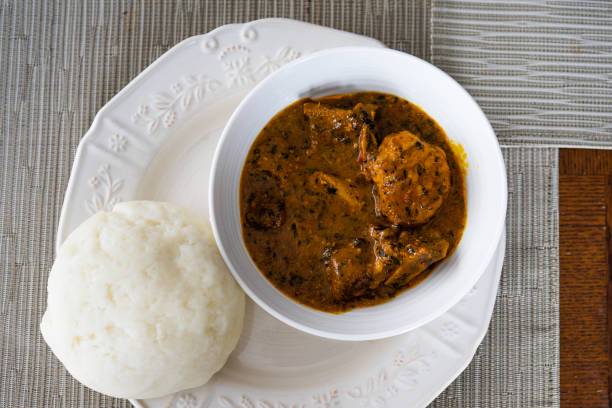Ogbono soup is a delicacy that steals your breath away at first taste. Not only is it delicious, but it is effortless and affordable to prepare.
An adequately prepared Ogbono soup is slimy and thick. It has a similar texture to Okra soup (another West African soup).
Both soups are fondly referred to as “Draw soup” because of their thick and slimy nature.
Today we’ll be looking at the nutritional benefits of Ogbono and how one can prepare a delicious pot of Ogbono soup.
However, before we look at the nutritional benefits of Ogbono soup and how to prepare it, let’s look at the seed’s history.
Ok, without wasting any more time, let the journey begin!
So,
What is Ogbono?
First, let’s get one thing out of the way: Ogbono is a seed derived from a fruit known as Bush mango.

The fruit, Bush mango, is also referred to as:
Wild mango
Dika nut
Bush mango
Apon
Goron
Ogbono is a multipurpose fruit native to West Africa and central Africa.
The fruit thrives in tropical areas and has two fruiting seasons; April-July and September-October. Generally, the fruit is available from May to September.
The ripe Ogbono fruit is oval-shaped and broad. It has a thin skin with fleshy pulp.
The seed is a soft brown kernel with a rugged exterior.
It’s this kernel that is eaten, and it’s what we call ogbono.
This highly nutritious seed is rich in protein, carbohydrates, and fat.
The seed can be eaten raw, roasted, or used to prepare the delicious ogbono soup. It is the grounded seed used to cook the soup that gives the soup its thick texture.
Now that we know the difference between the ogbono seed and fruit,
Let’s discuss the nutritional benefits of ogbono.
What are the Nutritional Benefits of Ogbono?
Asides from being the primary ingredient in ogbono soup, the seed also has a wide range of nutritional benefits.
It is rich in carbohydrates, fat, antioxidants, vitamins, and protein. Naturally, 100 grams of the seeds contain an average of:
650g of calories
60g of fat
20g of carbohydrates
12g of protein
8g of water
4g of dietary fibre
80mg of calcium
4mg of Iron
65mg of potassium
Research has shown that the oil extracted from the seed is a rich source of myristicin, lauric, palmitic, and oleic fatty acids.
Here is a detailed breakdown of the 6 nutritional benefits of ogbono.
Antioxidant activity
Antioxidants are essential for the body. They help in the neutralization of free radicals preventing oxidative damage. Free radicals cause cell damage when they move freely in the body.
They’re also one of the reasons why cancer, diabetes, and cardiovascular diseases occur. The flavanoid, ellagic acid, and lupeol content of ogbono are potent antioxidants that protect the body.
Diabetes
The normal range for fasting blood sugar is <100mg/dL. The person suffers from prediabetes symptoms when fasting blood sugar falls from 100mg/dL to 125mg/dL. Any level higher than 125mg/dL is considered full-blown diabetes.
Generally, an increased blood glucose level and insulin resistance cause diabetes. High blood sugar and insulin resistance are common symptoms of diabetes.
Studies show that the water-soluble dietary fibre in ogbono absorbs blood sugar. This prevents an increase in the blood sugar level after eating.
Another study also showed that ogbono helped to reduce the level of harmful cholesterol in the blood.
The mechanism of action of the ogbono seed is still unclear. Hopefully, more studies will reveal how the seed works its magic.
Reduces the Level of Harmful Cholesterol
High levels of bad cholesterol or bad cholesterol in the blood make one vulnerable to stroke and other heart-related diseases such as heart attack.
Scientific studies have shown that ogbono seed extracts reduce the level of harmful cholesterol and positively impact the level of good cholesterol.
This means that the seed has the potential to prevent the build-up of bad cholesterol, thereby reducing the chances of heart-related disease.
Weight loss
Ogbono is a natural weight loss ingredient. Interestingly, it is sold as a weight loss supplement. There is still much to be done to understand how ogbono causes weight loss.
However, data acquired from clinical studies showed that ogbono caused a reduction in weight in 102 overweight patients.
There was proof of a reduction in body weight, body fat, and waist circumference. It also had an impact on metabolic parameters associated with insulin resistance.
Despite these proofs, more studies must confirm that ogbono can lead to weight loss.
Guards the Body Against Infection
There are scientific claims that the African Mango tree’s leaf, root, and stem bark extracts have anti-inflammatory properties. This helps to protect the body from microbial and fungal infections.
Again, the mechanism of action behind how ogbono achieves this is still unclear.
Gastrointestinal activity
Some scientific studies show that ogbono plant extract has anti-ulcer and anti-diarrhoea properties. The study showed that the extract increased the level of mucus secretion.
Abdominal mucus helps to reduce the acidic activity in the gastrointestinal tract. This creates a protective layer that shields the tracts from abdominal acid.
Animal studies have also shown that ogbono extract prevents diarrhoea by reducing gastrointestinal mobility.
What are the Other Uses of Ogbono?
Ogbono might be used in preparing ogbono soup, but it has other uses. In this section, we’ll look at the different uses of ogbono:
Dika Bread
Dika bread is pounded ogbono. The seed is pounded into a cake. One beautiful thing about Dika cake is that it’s easy to use and can self-preserve for an entire year.
It’s because of Dika bread that the ogbono tree is also called the ‘Bread Tree.’
Oil Extract
The oil extracted from the seed is edible and can be used to cook. It can also be used in soap and cream making.
Fruit
The ogbono fruit, popularly called African mango, is a drupe. It’s yellowish and juicy when ripe. Its seed is what is referred to as ogbono seed, and it’s this seed that is used in the preparation of ogbono soup.
The juice can also be extracted to prepare jam, jelly, and wine. The pulp is used in the preparation of cloth dye.
Leaves
The leaves are traditionally used to treat fever and other ailments such as diarrhoea and stomach upset.
Bark
The ogbono tree’s bark is traditionally used as an analgesic to ease pain. The bark is crushed and applied topically on wounds and sores. It’s also used in the treatment of toothache.
Does Ogbono Have Any Side Effects?
So far, studies have shown that Ogbono is non-toxic and safe. However, more studies need to be done to confirm this.
It’s essential to be cautious with the prescription of ogbono in case of diabetes. Reckless administration might lead to drug-herb interactions.
Now that we’ve thoroughly looked into the history and benefits of ogbono, it’s time to learn how to prepare a delicious pot of ogbono soup;
How to Make Ogbono Soup
Ingredients:
- Chicken, Beef, or fish stock (the stock used depends on your choice of protein)
- Blended ogbono
- Protein of choice
- Palm oil
- Salt (as per taste)
- Periwinkle
- Ground crayfish
- Kale or Collard greens
- Pepper (fresh or grounded pepper)
- Onions
- Soup Seasoning
- Ugwu leaf
Instructions
- Rinse the meat or fish & put it into a pot and season to taste with salt, pepper, onion, and any other desired seasoning.
- Steam the meat or fish till it’s tender.
- Heat a bigger pot and pour your palm oil (ensure you don’t pour too much)
- Pour cut or blended onion into the pot and saute the onion for 1 minute.
- Add grounded ogbono into the pot and fry it for 1-2 minutes.
- Add meat or fish stock and leave the put to boil (make sure to leave your pot uncovered.)
- At this point, you can add additional water if the soup is too thick after it starts bubbling. If you add extra water, let it boil.
- Once the soup starts to bubble, add your meat or fish into the pot.
- Stir and allow the soup to cook for 3 minutes.
- Add crayfish, dried or fresh pepper, and the desired seasoning to taste.
- Add salt to taste ( it’s advisable to add your salt in little quantities, so you don’t use too much).
- Add periwinkle and let the soup boil for a minute or two.
- Add freshly cut ugwu leaf.
- Let the soup to cook for one minute (make sure you don’t overcook the leaf)
- Take off the heat, your delicious pot of ogbono soup is ready.
Serve with either garri, fufu, or any other complement of choice.
Conclusion
Ogbono soup is not just delicious, but it’s nutrient-filled.s mostly eat the soup, but the seed is native to Western and Central Africa.
The ogbono seed can be eaten raw, roasted, or cooked. Its oil can be used for cooking and in soap and cream making.
The seed is used in making Dika bread. This is why the parent tree is fondly called the Bread tree. The tree’s bark and leaves are traditionally used as an analgesic and antipyretic agents, respectively.



